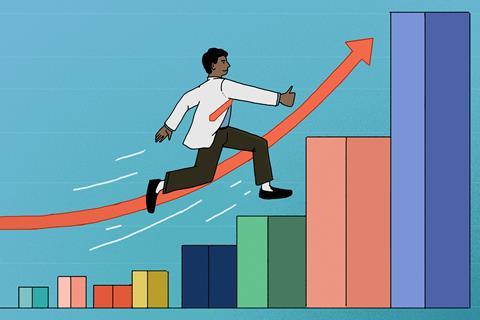Set your students on an upward trajectory in their interpretation of graphs

Scientist or not, we encounter graphs almost every day. And they’re an essential type of data representation in our chemistry teaching.
When trying to identify patterns or relationships in a graph, students first need to interpret its visual features. They can then go on to contextualise these patterns using appropriate prior knowledge of chemical concepts.
Existing work on graph comprehension and data interpretation in chemistry education suggests that many students find it challenging to connect relevant prior knowledge to data interpretation.
Teaching tips
- You can use the interview prompt and simulated peer review tasks to incorporate ideas from this study in your teaching.
- Consider preparing activities to help students identify relevant prior knowledge that will support productive reasoning.
- Try introducing different contexts for similar data interpretation activities to expand students’ knowledge base. This will increase the chances of activating prior knowledge that could productively frame their data interpretation.
- Expose students to alternative perspectives with a simulated peer review like the one used in this study. This will help if they’re struggling, their reasoning is unproductive or they’ve reached an incorrect explanation.
Prior knowledge is essential
Researchers from the US used the data-frame theory of sense-making to investigate how entry-level university chemistry students interpret graphical data to determine the optimal conditions for an experiment.
In data-frame theory, an experience – in this case, interpreting a graph – is understood through two interacting components. The first is the data, which is the observations made by reading the graph. The second is the frame, which is a mental construct that represents the interpretation and explanation of the data, informed by prior knowledge. Sense-making is the process of framing and reframing as new data is observed.
The researchers conducted think-aloud interviews with 18 chemistry students as they interpreted a graph to decide on the optimum concentration of HCl to isolate gold in a dual-phase extraction of waste electronic equipment. To further probe their reasoning, they asked students to participate in a simulated peer review by providing feedback on three sample responses written by the researchers.
Students interpreted the graphs and their features easily, suggesting that any difficulties they had with the task originated elsewhere.
Students could use relevant prior knowledge to try to tackle the task. However, not all prior knowledge was helpful. Several students’ reasoning was unproductive, and they abandoned their explanations when they realised the prior knowledge they were using was irrelevant. When students lacked prior knowledge, they used their everyday experiences to help complete the task.
Novice or expert?
Interestingly, while considered novices, the students displayed similar sense-making processes to those identified as experts. Both groups access prior knowledge to establish a frame for sense-making, but experts possess more relevant prior knowledge, leading to more sophisticated and productive reasoning.
The researchers also identified that students had more opportunities to reframe their understanding in the simulated peer review activity, which led to more correct interpretations. It was relatively simple for these students to read the information in the graph, suggesting any difficulty they had with interpretation was likely to do with connecting the data to appropriate prior knowledge. It is worth noting, though, that as these were entry-level university students, secondary school students may not have such well-developed graph skills.
Fraser Scott
Reference
Stephanie A. Berg and Alena Moon, Chem. Educ. Res. Pract., 2022, DOI: 10.1039/D2RP00154C
References
Stephanie A. Berg and Alena Moon, Chem. Educ. Res. Pract., 2022, DOI: 10.1039/D2RP00154C














No comments yet